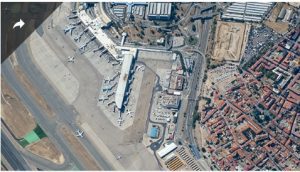The firm will evaluate the safety, capacity and logistical challenges of introducing drones into airport operations and provide planning standards for airports to follow.
DAYTON, Ohio (July 29, 2020) — Woolpert has been contracted to research and develop airfield design guidelines for large unmanned aircraft systems (UAS) for the Airport Cooperative Research Program (ACRP). The ACRP is managed by the Transportation Research Board of the National Academies of Science, Engineering and Medicine and sponsored by the Federal Aviation Administration (FAA). The primary audience for these guidelines will be airport managers, planners, engineers, UAS operators and other stakeholders.

Woolpert will evaluate large UAS vehicles and operations of varying types and sizes to identify where impacts to current design standards exist and publish guidance for the airport industry. Airfield design challenges, issues and considerations specific to the operational needs of large UAS will help determine whether to integrate or segregate, and identify gaps in planning, environmental impacts and infrastructure criteria. A large UAS is an unmanned aircraft vehicle (UAV) that weighs 55 pounds or more, including payload.
Woolpert Vice President and Principal Investigator Thomas Mackie said airports are becoming interested in the impact and facility needs of large UAS as they evaluate how manned and unmanned aircraft will operate in the same airspace and potentially use the same infrastructure.
“We will look at the current design criteria for airports, advisory circulars, FAA orders and engineering briefs to define what needs to be addressed when you add large UAS to the fold,” Mackie said. “There are differences as simple as turning radius and taxi time to wholescale infrastructure needs.
“In addition, many large UAS are going to be electric. There will be environmental, noise, communication, fire and rescue support, navigation concerns, surface infrastructure, support facilities, power and battery support, and other unique storage needs. This guidebook will ensure airports can identify gaps in their existing infrastructure and what could be required to support large UAS operations.”
Woolpert has a long history supporting the design, engineering and geospatial needs of airports and air bases worldwide and is leading the industry in UAS integration and research. It was the first surveying and aerial mapping company approved by the FAA to fly UAS commercially in designated airspace. The firm has helped airports, state departments of transportation, and governmental agencies develop standards and safely integrate UAS into their operations. Woolpert also is developing a guidebook for the National Safe Skies Alliance to help airports respond to UAS threats.
For this project, Woolpert has assembled a highly specialized, senior advisory team of airport design and planning experts who also have direct experience in integrating UAS into airport operations. Faith Group and Ricondo will assist in research and development. The team’s findings will be published as a guidebook anticipated for late 2021.
“Unmanned technology will continue to advance—from unmanned aircraft making deliveries to eVTOLs for passenger transport and beyond—and airports will need to know how to structure their airfields to best serve these emerging aircraft operations,” Mackie said. “The guidance developed by Woolpert under ACRP will close the gap between the current criteria and the future of unmanned systems.”
About Woolpert
Woolpert is committed to a vision to become the premier architecture, engineering, geospatial (AEG) and strategic consulting firm, and one of the best companies in the world. It’s a vision we’ve been fine-tuning for decades. It guides our decisions and investments, provides our clients with optimal solutions and offers our employees unrivaled opportunities. Woolpert is recognized as a Great Place to Work by its employees and is America’s fastest-growing AEG firm. With more than a century of experience, close to 1,000 employees and 30 offices, Woolpert supports public, private, federal, and U.S. military clients nationally and around the globe. For more information, visit woolpert.com and connect with us on LinkedIn, Twitter, Facebook and Instagram